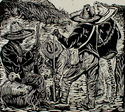
19th, 20th & 21st Century Fine Prints
707-546-7352 · fax 707-546-7924 · web: www.annexgalleries.com · email: artannex@aol.com
Elena Huerta Muzquiz Biography
Elena Huerta Muzquiz
Mexican
1908–1998
Biography
Painter, printmaker, and muralist Elena Huerta Muzquiz was born in Saltillo, Coahuila, Mexico on July 15, 1908 into a prominent political family. Showing an early aptitude for art, she was given lessons from a young age, but upon her father's passing her family's wealth declined and she took several jobs to pay for her education. She studied under Ruben Hererra at the Saltillo Art Academy beginning in the late 1920s, earning a teaching degree in her first year and working as a primary school art teacher while completing her studies. Upon graduation she moved to Mexico City to take painting courses at the Academy of San Carlos. Her time with Hererra would continue to influence her style throughout her career and she would become the most prominent member of his art movement, Corriente Pictoria de Saltillo.
In the 1930s Mexican muralism was on the rise in the art world, and Muzquiz associated with leading muralists such as Diego Rivera and David Siqueiros, whose brother-in-law she would eventually marry. She was also a member of the Mexican Communist Party and was an activist, founding the League of Revolutionary Writers and Artists (LEAR) in 1933 along with Leopoldo Mendez, Pablo O'Higgins, Luis Arenal, and others. She was also a founder of the children's puppet theater company Compania de Teatro Infantil, for whom she worked for six years beginning in 1931. Teaching would become a major part of Muzquiz's career from the late 1930s onward, including at the Taller de Grafica Popular (TGP), where she first taught in 1939.
Recurring health problems led Muzquiz to look for medical treatment that wasn't available in Mexico or the United States. Having visited the Soviet Union several times, she was able to find experimental treatements there even as the Second World War was ramping up. Putting her career on hold, she left with her family for Eastern Europe, living in the Soviet Union for much of the war. In 1948 they returned to Mexico and after a time she was hired by the Museum of Fine Arts at the Instituto Nacional de Bellas Artes (INBA) as well as the TGP. Now a divorced mother of three, she raised her two daughters and son on her own, inspiring them to pursue the arts as well.
Muzquiz's career included directorship of the Jose Guadalupe Posada Gallery in 1951 and the Jose Clemente Orozco Gallery in 1952, and in the meantime she continued to teach and work on her own art. During this time she traveled to China, Cuba, and Russia. She retired in 1972 and moved to Monterrey where, at age 65, she was commissioned by the president of her home town, Saltillo, to paint a mural of the city's history at the municiple hall. She agreed, and from 1973 to 1975 she executed what would become the largest mural done by a woman in Mexico's history measuring 4,840 ft. In all, Muzquiz's mural work would also become significant as being the largest body of mural work done by a woman artist in 20th century Mexico, as well as being among the last to be true to the classic Mexican Muralist style. Ironically, though she had retired from teaching, it wasn't long before she took up teaching more classes in drawing and printmaking, now at the Universitario Panamericano and the Univeridad Autonoma de Nuevo Leon.
Elena Huerta Muzquiz died in July of 1998 in Monterrey, Mexico. Her only surviving child, Sandra, continues to work as a writer and activist.



